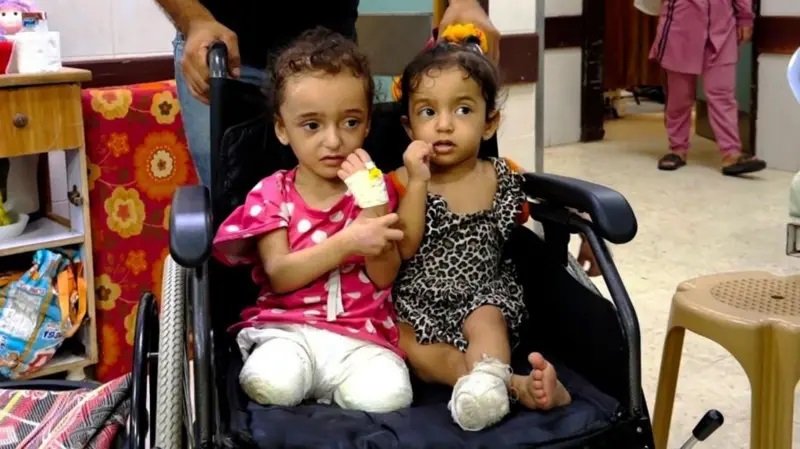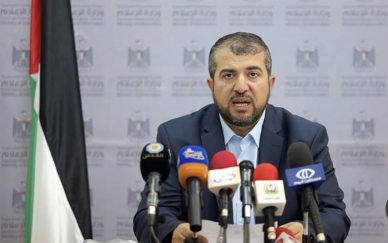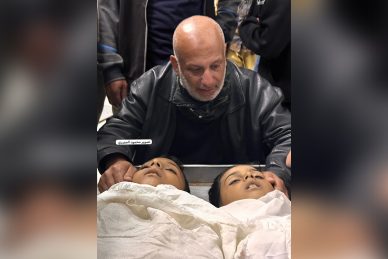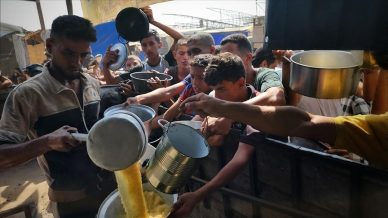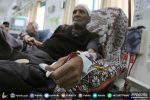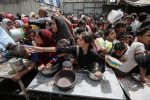GAZA, (PIC)
Fifteen-year-old Abdulrahman Musleh struggles every day to meet his daily needs using a wheelchair after losing his legs in an Israeli massacre in the Al-Nuseirat refugee camp in central Gaza Strip eight months ago.
All Musleh recalls about the incident is that the Israeli occupation army launched a massive attack on the camp located in the center of the Gaza Strip, finding himself among about 300 martyrs and wounded.
Musleh did not know what happened to him after the sound of consecutive explosions, one of which threw him to the ground as white and black fungal clouds covered the sky. The boy fell into a coma for days, only to wake up in a recovery bed unable to move after losing both legs.
This tragedy was not the only shock for a boy of his age racing against the winds, as he later learned he had lost most of his family members. Musleh spent two months in the hospital for treatment before leaving to his aunt’s house to begin a new, difficult life without lower limbs to help him meet his needs.
Musleh describes the feeling of living without limbs as the harshest feeling one can experience, saying, “It’s not easy to push your wheelchair alone in streets filled with demolished houses, and it’s not easy to enter the bathroom to relieve yourself.” However, the boy says he has no choice but to fight with all his strength to adapt to his new health condition while waiting to receive prosthetic limbs to help him cope with the challenges of life in the Gaza Strip.
Children who have had their limbs amputated live in a tragic reality that does not end even after the war. The health crisis in the besieged Strip makes obtaining treatment nearly impossible. On one hand, the shortage of medical supplies and painkillers increases the suffering, and on the other, traveling abroad for prosthetics has become a distant dream due to the ongoing blockade and the Israeli occupation’s continued violations of the ceasefire agreement with the resistance.
Those in need of prosthetics urge international health organizations and the Ministry of Health in the Gaza Strip to urgently address their health situations and facilitate their travel for treatment abroad, as a step towards restoring their normal lives, especially after the painful months they endured during the war.
Ahmed lost his dream
Mohammad Abu Abtihan, the father of child Ahmed, says his son lost part of his foot in an Israeli bombing, and he is now working to provide his child with a prosthetic limb instead of his amputated foot, noting that this is one of the most challenging tasks in the Gaza Strip.
Abu Abtihan explained to Sky News Arabia, “My child has been deprived of his life and dreams, and he can no longer play football, which is his favorite hobby, in addition to being unable to perform even the simplest daily tasks.”
He questioned, “What sin has my nine-year-old child committed for his life to end before it even begins? What adds to his suffering is the lack of basic necessities for fitting prosthetics in the Gaza Strip,” stressing the need for urgent international intervention for this category of injured individuals.
According to the Information Systems Department at the Ministry of Health in Gaza, the number of amputations since the beginning of the war has reached approximately 4,500 cases, but the recorded cases do not exceed 1,302, including 1,041 males and 261 females, while the percentage of children is 15%, and the percentage of amputations in the lower limbs is 83% of the total.
Additionally, there are 14,500 severe injuries requiring long-term rehabilitation, coinciding with a significant shortage of medical supplies and medications, and the destruction of most hospitals in the Gaza Strip, and the exhaustion of the health system due to the targeting of health centers and medical staff by the occupation army.
A catastrophic situation
Zaher Al-Wahidi, director of the Health Information Unit at the Ministry of Health, describes the situation of amputees as catastrophic, not only due to the number of injuries but also due to the lack of necessary care, especially for amputated children, most of whom need prosthetic limbs and physical and psychological rehabilitation. However, the blockade makes all of this nearly impossible.
Earlier, the United Nations confirmed that the Gaza Strip has become home to the largest group of amputee children in modern history, with 10% children among the 11,780 injured in the war having lost one or both legs.
According to data published by the World Health Organization a month before the announcement of the ceasefire in Gaza, 1 in 4 people injured in the Gaza war needs rehabilitation services, including post-amputation care and spinal cord injury treatment.
Amputees struggle to continue their lives burdened by painful memories of the war, amid challenges of scarce medical resources and the unavailability of suitable prosthetics for all cases, along with difficulties in bringing them into the Gaza Strip.
The Gaza municipality manages a center for prosthetics, visited daily by dozens of injured individuals seeking prosthetic limbs. It also offers physical rehabilitation services through physiotherapy exercises that may take up to three months to help injured bodies adapt to the prosthetic limb.
The center resumed partial operations on July 22, after halting at the beginning of the war, with funding from the International Committee of the Red Cross, and operations expanded in October, according to Nevin Al-Ghussein, acting director of the center.
Al-Ghussein says that the need is great, and resources are scarce, indicating that 10 individuals have actually received their prosthetics, including 5 children, while 20 others are waiting for their turn after completing their rehabilitation process. Meanwhile, the center faces difficulties due to the lack of fuel needed to operate the generator that powers its machines.
Despite the important role played by the center, its services remain limited due to the inability of the wounded in southern Gaza Strip—where the vast majority of the population resides—to access it.
There is no accurate information on the number of people who had their limbs amputated during the genocide war, but estimates suggest they are between 5,000 to 6,000 individuals, according to the spokesperson for the International Committee of the Red Cross, Hisham Mahna.
He adds that the Red Cross has launched a program to assist this group, with approximately 5,000 injured registered for the purpose of providing them with prosthetic limbs, clarifying that implementing the program is not without challenges, the most important of which is the limited humanitarian support that the occupation allows to enter the Gaza Strip, including assistive devices and necessary tools for preparing and fitting prosthetic limbs, in addition to the difficulty of moving between the Gaza Strip’s governorates.
High amputation rates
Marwan Al-Hams, director of field hospitals in Gaza, states that “the Gaza Strip has recorded the highest rates of amputations and deformities due to the war in Gaza,” noting that the type of weapons used by Israel was dangerous.
Al-Hams explains that the injuries reaching the hospitals during the war were of a different nature, as amputation cases showed limb severance by very sharp instruments, and burns and deformities were severe, “indicating the use of unknown and possibly secret materials.”
The medical official did not rule out the possibility that Israel used internationally prohibited weapons and tools to increase the rates of deformity and amputation among the residents of the Gaza Strip, noting that the majority of the injured suffered either deformities due to burns and injuries or cases of amputation.
He added that most victims arriving at hospitals were in pieces, “and unfortunately, due to the suffocating Israeli blockade, there was no capacity to deal with those cases properly on both medical and psychological levels.”
He continued, “We currently face difficulties in providing alternative prosthetic limbs for thousands of amputees, and we lack the capacity to perform reconstructive surgeries for those whose faces and bodies have been disfigured due to Israeli missiles and shells.”
He pointed out that “the Gaza Strip, with its five governorates, has only one center for prosthetics, and despite the resumption of work there with the entry of the ceasefire into effect in Gaza, the center lacks many necessary equipment and supplies to meet the needs of amputees, while the territory lacks the means to perform reconstructive surgeries.”

